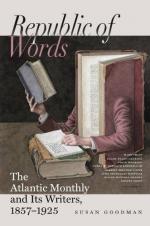As for those I speak of, I pluck them as a wild fruit, native to this quarter of the earth,—fruit of old trees that have been dying ever since I was a boy and are not yet dead, frequented only by the woodpecker and the squirrel, deserted now by the owner, who has not faith enough to look under their boughs. From the appearance of the tree-top, at a little distance, you would expect nothing but lichens to drop from it, but your faith is rewarded by finding the ground strewn with spirited fruit,—some of it, perhaps, collected at squirrel-holes, with the marks of their teeth by which they carried them,—some containing a cricket or two silently feeding within, and some, especially in damp days, a shelless snail. The very sticks and stones lodged in the tree-top might have convinced you of the savoriness of the fruit which has been so eagerly sought after in past years.
I have seen no account of these among the “Fruits and Fruit-Trees of America,” though they are more memorable to my taste than the grafted kinds; more racy and wild American flavors do they possess, when October and November, when December and January, and perhaps February and March even, have assuaged them somewhat. An old farmer in my neighborhood, who always selects the right word, says that “they have a kind of bow-arrow tang.”
Apples for grafting appear to have been selected commonly, not so much for their spirited flavor, as for their mildness, their size, and bearing qualities,—not so much for their beauty, as for their fairness and soundness. Indeed, I have no faith in the selected lists of pomological gentlemen. Their “Favorites” and “None-suches” and “Seek-no-farthers,” when I have fruited them, commonly turn out very tame and forgetable. They are eaten with comparatively little zest, and have no real tang nor smack to them.
What if some of these wildings are acrid and puckery, genuine verjuice, do they not still belong to the Pomaceae, which are uniformly innocent and kind to our race? I still begrudge them to the cider-mill. Perhaps they are not fairly ripe yet.
No wonder that these small and high-colored apples are thought to make the best cider. Loudon quotes from the “Herefordshire Report,” that “apples of a small size are always, if equal in quality, to be preferred to those of a larger size, in order that the rind and kernel may bear the greatest proportion to the pulp, which affords the weakest and most watery juice.” And he says, that, “to prove this, Dr. Symonds, of Hereford, about the year 1800, made one hogshead of cider entirely from the rinds and cores of apples, and another from the pulp only, when the first was found of extraordinary strength and flavor, while the latter was sweet and insipid.”
Evelyn says that the “Red-strake” was the favorite cider-apple in his day; and he quotes one Dr. Newburg as saying, “In Jersey ’t is a general observation, as I hear, that the more of red any apple has in its rind, the more proper it is for this use. Pale-faced apples they exclude as much as may be from their cider-vat.” This opinion still prevails.




